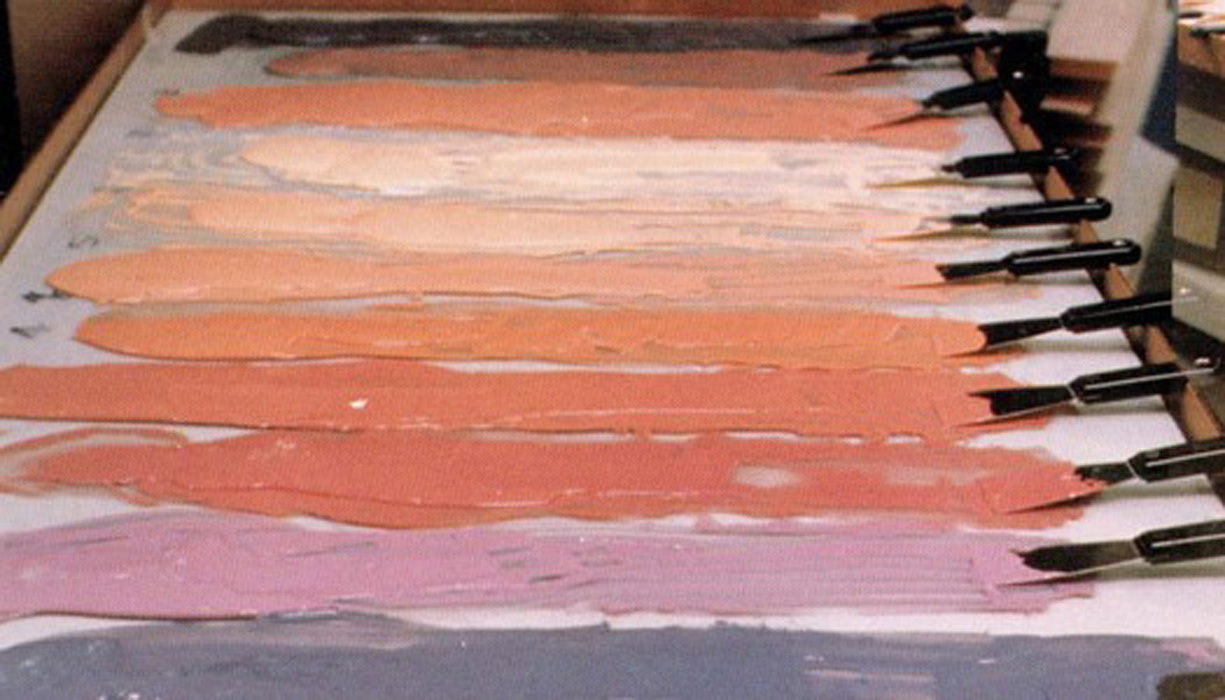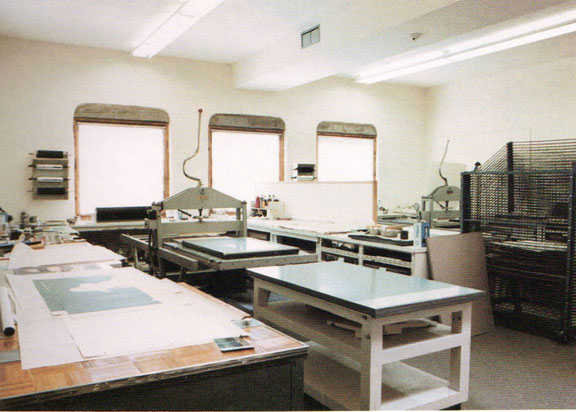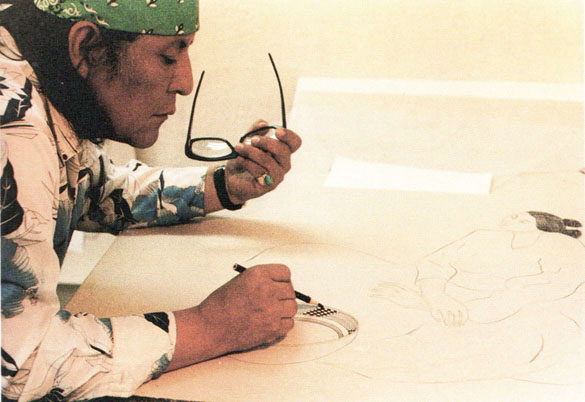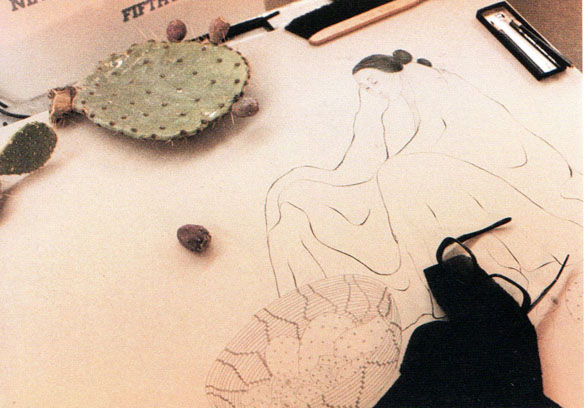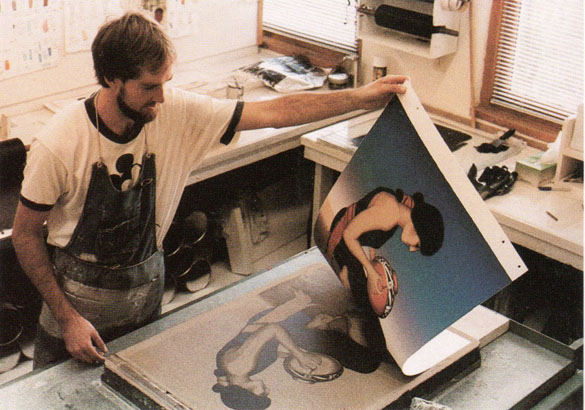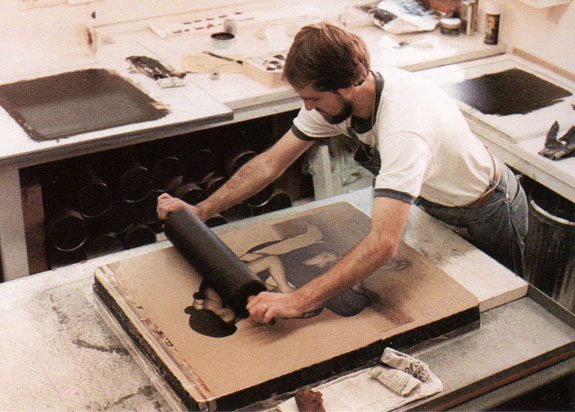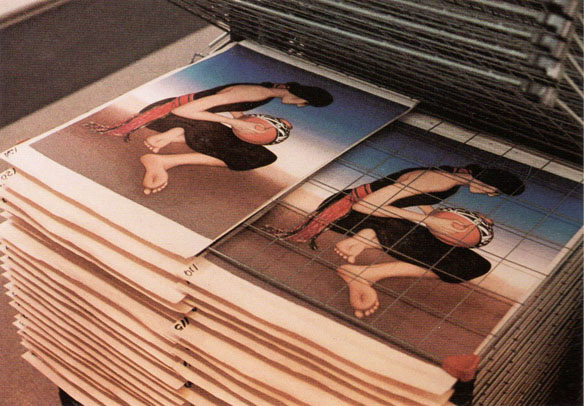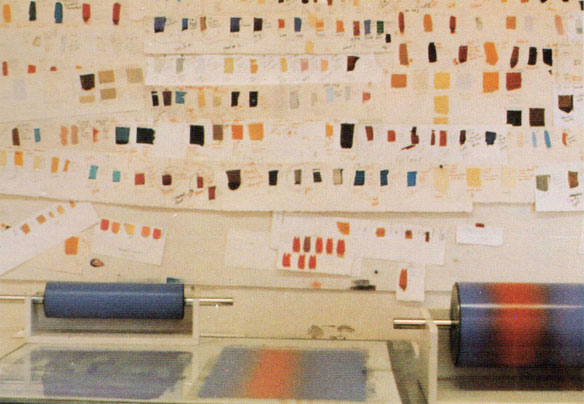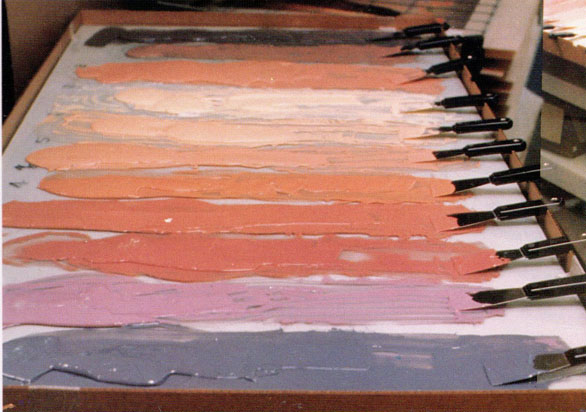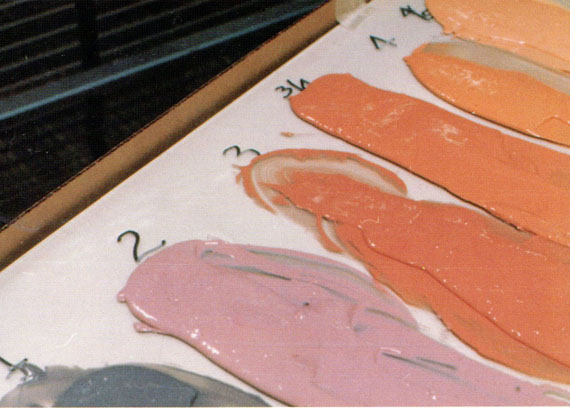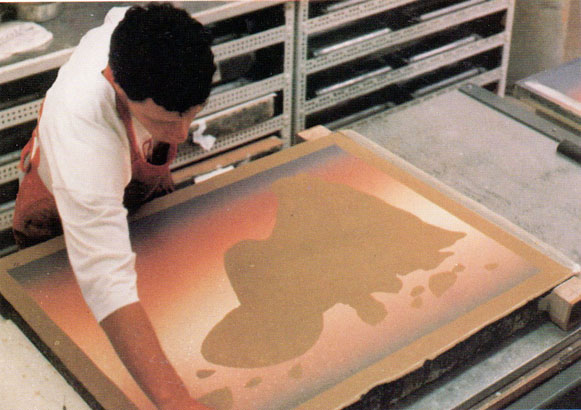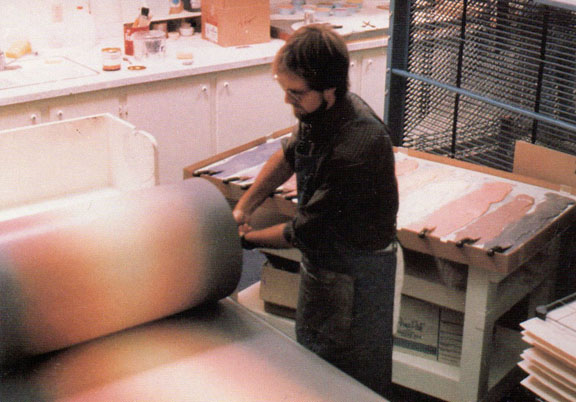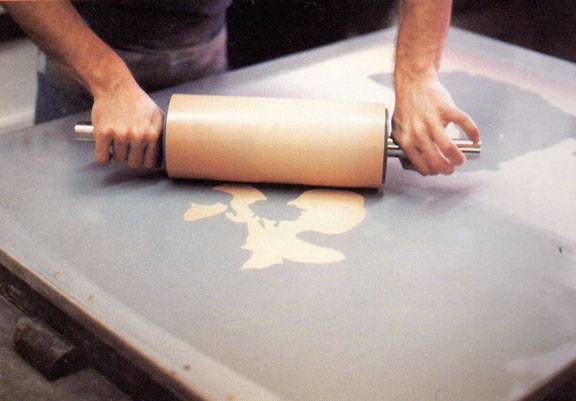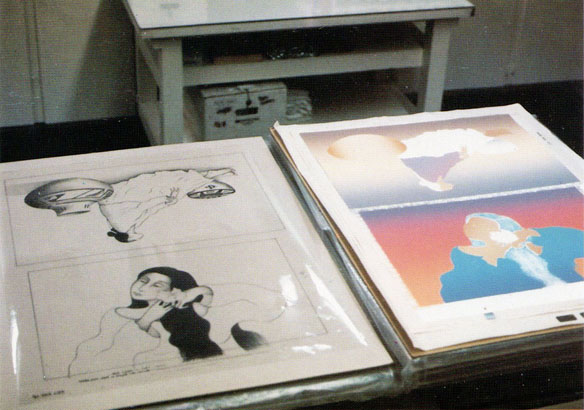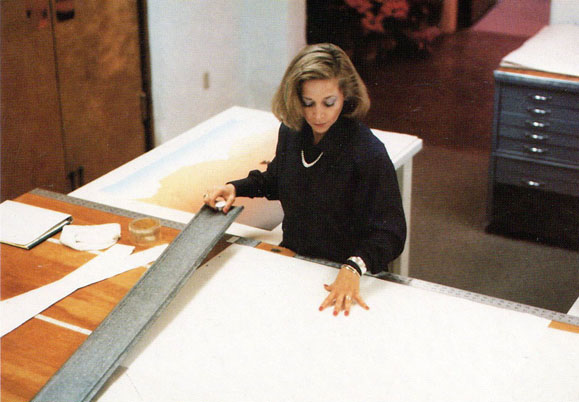|
Arabic Numbered Impression. Impressions from the commercial edition are usually designated by an Arabic number over another Arabic number. The lower number indicates the size of the edition, the upper number the sequence in which the impressions have been signed. In the printing of an edition of lithographs the first impression should be no different than the last impression signed, thus there is no reason to record the sequence in which they are printed. In color lithography such a practice would be fruitless in any event because the impressions are not normally printed in the same sequence as each color is added. In lithography, the true meaning of the number l/20 for example is that the impression is one of an edition of 20 Arabic numbered impressions, not specifically that it is the first pulled of twenty impressions. Each impression in the Arabic numbered edition is compared to the bon a' tirer and should be essentially like it.
In Intaglio printing, the first impressions pulled are generally of better quality than later impressions, due to abrasion of the printing plate during the printing process. In an edition of etchings for example, the number of the impression should indicate the sequence of printing. With the availability of more modern techniques and the plating of etching plates to reduce abrasion, editions of etchings are now generally more consistent and the higher numbers in the edition are more comparable to the lower numbers.
Archive Impression. These impressions are retained by the workshop for purposes of study, reference and exhibition. They are signed as archive impressions and are comparable to the bon a' tirer.
Artist's Edition. See Arabic Numbered Impression.
Artist's Proof. The artist proof is an impression of comparable quality to the impressions of the numbered edition. These impressions are usually retained by the artist and should be limited in number, to a small percentage of the total number of impressions in the edition.
Bon a Tirer. The bon a' tirer is the first impression which is fully acceptable to the artist and the printer. This impression serves as the standard of quality to which each impression is compared. It is printed on the same paper as the edition and is inscribed by the artist "Bon a' Tirer" to authorize printing of the edition.
Cancellation Proof. A proof or impression pulled from a defaced stone, plate, block or screen to show that the edition has been limited and no further prints can be made from the artist's original art work.
Color Separation Proof. A color separation proof is an impression of a single run printed in the color of the edition.
Color Trial Proof. Color trial proofs are printed prior to the bon a' tirer. A color trial proof differs from the edition in the color of the ink that is used. These impressions result as colors are adjusted and tried or "proofed." Color trial proofs record variations in color and in the proofing of a complex color print there may be many of them, each differing from the other. At the discretion of the artist, these proofs may be signed "color trial proof", "CTP", or they may be destroyed.
Copyright Blindstamp. A stamp, printed in ink, on the reverse of each impression in the edition which discloses the owner of the copyright.
Documentation. The documentatiion is the disclosure statement, of pertinent information about an edition. it is a record of the execution and printing of the edition and a statement of authenticity.
Edition. The total number of prints pulled and signed by the artist. In addition to the bon a' tirer and Arabic numbered impressiions, an edition of prints might also include artist's proofs, roman numbered impressions, record or archive impressions, publisher's proofs, presentation proofs, museum impressions, hors commerce impressions, printer's proof, color trial proofs, trial proofs or any combination thereof.
Etching. An intaglio process in which an acid-resistant ground is applied to a metal p0late, usually copper or zinc, and an image is cut into the ground by the artist using an etching needle or another tool to expose the metal of the plate. Acid is then applied to bit the plate, eating away the exposed lines. The time the plate is exposed to the acid as well as temperature determines the depth of the lines. When the plate is inked, covered with the dampened paper, and run through an etching press, the pressure of the press forces the paper into the etched lines of the drawing and ink is transferred to the paper. This results in an impression or print of the image on the plate.
Hors Commerce. A European designation for impressions from the edition that are of quality, fully comparable to the Arabic numbered edition, sometimes printed on a special paper.
Intaglio. One of the four major divisions of printmaking in which an image is either cut or bitten by acid into a metal plate, usually copper or zinc. Intaglio includes a number of different techniques such as etching mezzotint, drypoint, engraving and aquatint. Intaglio prints may consist of one or any combination of these techniques.
Impression. An imprint on paper or some other material resulting from contact with an inked image on stone, plate, block or screen.
Linoleum Cut. A relief print, sometimes called a linocut, made from an image cut into a piece of linoleum. This technique was made famous by Picasso; who used the medium in an inventive way to produce fine art prints. Prior to Picassco's use of this printmaking medium the linoleum cut was considered to be an inexpensive and elementary print medium in primary schools and arts and crafts workshops.
Lithograph. See Original Lithograph.
Lithography. One of the four major divisions of printmaking in which a drawing is made with a greasy substance on a stone (limestone, marble, onyx) or metal plate (aluminum or zinc). The surface is then treated chemically so that the image areas accept ink and the non-image areas, when dampened with water, repel ink. Lithography is a planographic medium with impressions pulled from a perfectly flat surface, unlike intaglio and woodblock printing in which the surface is in relief.
Lithography was invented, in 1798 by a German, Alois Senefelder who had been experimenting with limestone slabs from the nearby quarry of Solnhofen (Bavaria). One day he was asked by his mother to write down a laundry list and he made the list with his homemade ink on a clean stone. Before washing the stone off, he became curious as to what would happen if he treated the stone with aqua fortis (nitric acid) and water. When he washed off the stone he discovered that the greasy areas accepted ink and the untouched areas, when dampened with water, rejected ink because of the natural antipathy of grease and water. The greasy letters accepted even more ink when rolled with an inking roller and the first lithographic print was born. Senefelder continued to experiment to refine and perfect his technique, using a gum solution to make the stone even more receptive and absorbent of water. The basic techniques developed by Senefelder have been passed on almost intact to the current generation of artists and printers, however, even though the principles involved in the printing of fine multi-color lithographs are very simple, the technical processes are complex and require a great deal of skill and expertise. Today lithography is probably the most popular of all printmaking media, offering artists and printers the widest range of techniques.
Museum Impression. Museum impressions originated at Western Graphics Workshop where artists, at the discretion of workshop were given the option of designating one or more impressions from each edition as museum impressions. These impressions are generally donated to museums of the workshop's choice in an effort to help museums build their print collections and bring new work before the public.
Original Lithograph. A print conceived and executed by the artist on a flat stone or plate and printed either by the artist or a collaborating printer. Each impression is pulled directly from the artist's drawing unlike offset lithography where the image is "offset' from a rubber blanket. Because each impression is pulled directly from the artist's original drawing, each impression is an original lithograph.
Presentation Proof. Impressions which are essentially the same as the bon a' tirer which the artist has inscribed for a friend, collaborator or collector. If such impressions bear no designation other than the artist's designation or inscription, they should be recorded in the documentation as presentation proofs.
Printer's Chop. The personal embossed seal, of the collaborating printer or principal printer of the edition. When this chop or embossed seal is used, it is usually at the bottom of each impression and will be on each impression in the edition.
Printer's Proof. At the discretion of the artist and/or workshop, the printer(s) who prints the edition may be given a proof in recognition of a job well done. When a printer is given a proof, the proof is inscribed by the artist as printer's proof or PP. In some editions, there may be a number of printer's proofs depending on how many printers worked on the edition. The printer's proof is on the same paper as the edition and is essentially identical to the bon a' tirer.
Progressive Proof. An impression printed in the colors of the edition showing a successive sequence of runs
.
Publisher's Proof. A publisher's proof is an impression of a quality comparable to the printed edition and the bon a tirer. It is considered the personal property of the publisher of the edition.
Record Impression. Impressions retained by the workshop for purposes of study, reference and exhibition. They are signed as record impressions and are comparable to the bon a' tirer. the edition.
Roman Numbered Impressions. In addition to the regular Arabic numbered edition, a smaller reserved or preferred edition may be printed. To distinguish these impressions from the Arabic numbered impressions they are designated with roman numbers. They may be sold either as a subscription series to individual collectors or institutions or as individual impressions.
Run. A single inking and printing of a single drawing from a stone, plate, block or screen.
Separation Proof. An impression of a single run printed in black to show an individual run as drawn by the artist.
Serigraphy. One of the four major divisions of printmaking, commonly referred to as silkscreen printing. Serigraphy is essentially a stencil process, in which ink is forced with a squeegee through a silk screen onto the paper below. The non-image areas of the print are blocked out with a mask of glue, paper or some other specially prepared material to stop out the screen, allowing ink to pass through the screen only in the image area. Silkscreen printing was held in low esteem for more than a quarter of a century because of its unfavorable reputation as a purely commercial medium, however, with the development of new techniques and increased interest by artists in the medium, serigraphy has become an art form in its own right.
Silkscreen. A general term used to describe the screen processed images for commerce and industry. In order to distinguish fine art prints from the purely commercial work, a new term was later coined and fine art silkscreen prints became known as serigraphs.
State. A term used to describe a print that shows work in a particular state of development or to distinguish between editions of the same or closely related images such as State I, State II, State III, etc. During the proofing process, an artist will view as number of different proofs. Occasionally, several proofs will appeal to the artist for different aesthetic reasons or he may wish to print one edition of a particular proof and then make additions or deletions and print a second edition. In such cases, the first edition printed is designated State I, the second edition State II, and so on.
State Proof. State proofs are impressions that differ markedly from the numbered edition. They come into being prior to the major alterations in the stone or plate. If an image under goes a series of major modifications there may well be a series of differing state proofs which together record the evolution of the image.
Trial Proof. An impression printed prior to the bon a' tirer. It may be in the colors of the edition but printed prior to minor additions or deletions in the image or on a different paper from the edition. A trial proof may also be an impression printed in black from a one run, one color image either on the same paper as the edition or on a different paper from the edition.
Woodcut. The most ancient form of printmaking with beginnings in Egypt and China. it is a relief process in which a plank grain wood block is cut with a knife, gouge and chisels leaving the image areas in relief. The woodcut has traditionally involved the artist working with a skilled craftsman or cutter who would cut the designs into the blocks and a master printer who would print the images. This medium achieved its highest expression in the beautiful woodcuts of the Japanese. With the availability of new materials and approaches to the medium, the woodcut is once again becoming a popular art form with artists.
Workshop Chop. The embossed seal of the workshop where the impression is printed. This chop or seal generally appears at the bottom of each impression in the edition.
|
.jpg)
